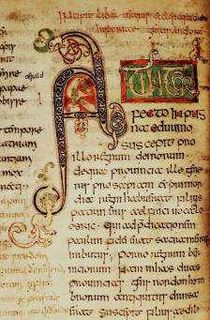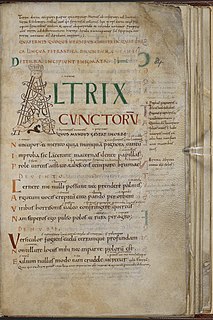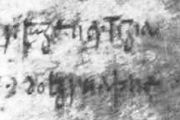Related Research Articles
Old English literature refers to poetry and prose written in Old English in early medieval England, from the 7th century to the decades after the Norman Conquest of 1066, a period often termed Anglo-Saxon England. The 7th century work Cædmon's Hymn is often considered as the oldest surviving poem in English, as it appears in an 8th-century copy of Bede's text, the Ecclesiastical History of the English People. Poetry written in the mid 12th century represents some of the latest post-Norman examples of Old English. Adherence to the grammatical rules of Old English is largely inconsistent in 12th-century work, and by the 13th century the grammar and syntax of Old English had almost completely deteriorated, giving way to the much larger Middle English corpus of literature.

Cædmon is the earliest English poet whose name is known. A Northumbrian who cared for the animals at the double monastery of Streonæshalch during the abbacy of St. Hilda, he was originally ignorant of "the art of song" but learned to compose one night in the course of a dream, according to the 8th-century historian Bede. He later became a zealous monk and an accomplished and inspirational Christian poet.
The Old English Bible translations are the partial translations of the Bible prepared in medieval England into the Old English language. The translations are from Latin texts, not the original languages.

Deusdedit was a medieval Archbishop of Canterbury, the first native-born holder of the see of Canterbury. By birth an Anglo-Saxon, he became archbishop in 655 and held the office for more than nine years until his death, probably from plague. Deusdedit's successor as archbishop was one of his priests at Canterbury. There is some controversy over the exact date of Deusdedit's death, owing to discrepancies in the medieval written work that records his life. Little is known about his episcopate, but he was considered to be a saint after his demise. A saint's life was written after his relics were moved from their original burial place in 1091.
Northumbrian was a dialect of Old English spoken in the Anglian Kingdom of Northumbria. Together with Mercian, Kentish and West Saxon, it forms one of the sub-categories of Old English devised and employed by modern scholars.
Mercian was a dialect spoken in the Anglian kingdom of Mercia. Together with Northumbrian, it was one of the two Anglian dialects. The other two dialects of Old English were Kentish and West Saxon. Each of those dialects was associated with an independent kingdom on the island. Of these, all of Northumbria and most of Mercia were overrun by the Vikings during the 9th century. Part of Mercia and all of Kent were successfully defended but were then integrated into the Kingdom of Wessex. Because of the centralisation of power and the Viking invasions, there is little to no salvaged written evidence for the development of non-Wessex dialects after Alfred the Great's unification, until the Middle English period.
Kentish was a southern dialect of Old English spoken in the Anglo-Saxon kingdom of Kent. It was one of four dialect-groups of Old English, the other three being Mercian, Northumbrian, and West Saxon.

The Saint Petersburg Bede, formerly known as the Leningrad Bede, is an Anglo-Saxon illuminated manuscript, a near-contemporary version of Bede's 8th century history, the Historia ecclesiastica gentis Anglorum. Although not heavily illuminated, it is famous for containing the earliest historiated initial in European illumination. It is so named because it was taken to the Russian National Library of Saint Petersburg in Russia at the time of the French Revolution by Peter P. Dubrovsky.

British Library, MS Cotton Tiberius C. II, or the Tiberius Bede, is an 8th-century illuminated manuscript of Bede's Historia ecclesiastica gentis Anglorum. It is one of only four surviving 8th-century manuscripts of Bede, another of which happens to be MS Cotton Tiberius A. XIV, produced at Monkwearmouth–Jarrow Abbey. As such it is one of the closest texts to Bede's autograph. The manuscript has 155 vellum folios. This manuscript may have been the Latin text on which the Alfredian Old English translation of Bede's Ecclesiastical History was based. The manuscript is decorated with zoomorphic initials in a partly Insular and partly Continental style.

The Vespasian Psalter is an Anglo-Saxon illuminated psalter decorated in a partly Insular style produced in the second or third quarter of the 8th century. It contains an interlinear gloss in Old English which is the oldest extant English translation of any portion of the Bible. It was produced in southern England, perhaps in St. Augustine's Abbey or Christ Church, Canterbury or Minster-in-Thanet, and is the earliest illuminated manuscript produced in "Southumbria" to survive.

The Blickling Homilies is the name given to a collection of anonymous homilies from Anglo-Saxon England. They are written in Old English, and were written down at some point before the end of the tenth century, making them one of the oldest collections of sermons to survive from medieval England, the other main witness being the Vercelli Book. Their name derives from Blickling Hall in Norfolk, which once housed them; the manuscript is now Princeton, Scheide Library, MS 71.

The Stowe Psalter is a psalter from the "2nd or 3rd quarter of the 11th century", at the end of Anglo-Saxon art. The text includes the Gallican version of the Psalms, followed by the Canticles with an interlinear Old English gloss.

The Eadwine Psalter or Eadwin Psalter is a heavily illuminated 12th-century psalter named after the scribe Eadwine, a monk of Christ Church, Canterbury, who was perhaps the "project manager" for the large and exceptional book. The manuscript belongs to Trinity College, Cambridge and is kept in the Wren Library. It contains the Book of Psalms in three languages: three versions in Latin, with Old English and Anglo-Norman translations, and has been called the most ambitious manuscript produced in England in the twelfth century. As far as the images are concerned, most of the book is an adapted copy, using a more contemporary style, of the Carolingian Utrecht Psalter, which was at Canterbury for a period in the Middle Ages. There is also a very famous full-page miniature showing Eadwine at work, which is highly unusual and possibly a self-portrait.

Cædmon's Hymn is a short Old English poem attributed to Cædmon, a supposedly illiterate and unmusical cow-herder who was, according to the Northumbrian monk Bede, miraculously empowered to sing in honour of God the Creator. The poem is Cædmon's only known composition.

Anglo-Saxon riddles are a significant genre of Anglo-Saxon literature. The riddle was a major, prestigious literary form in early medieval England, and riddles were written both in Latin and Old English verse. The pre-eminent composer of Latin riddles in early medieval England was Aldhelm, while the Old English verse riddles found in the tenth-century Exeter Book include some of the most famous Old English poems.

The Cleopatra Glossaries are three Latin-Old English glossaries all found in the manuscript Cotton Cleopatra A.iii. the glossaries constitute important evidence for Old English vocabulary, as well as for learning and scholarship in early medieval England generally. The manuscript was probably written at St Augustine's, Canterbury, and has generally been dated to the mid-tenth century, though recent work suggests the 930s specifically.
The "Leiden Riddle" is an Old English riddle. It is noteworthy for being one of the earliest attested pieces of English poetry; one of only a small number of representatives of the Northumbrian dialect of Old English; one of only a relatively small number of Old English poems to survive in multiple manuscripts; and evidence for the translation of the Latin poetry of Aldhelm into Old English.

The Tiberius Psalter is one of at least four surviving Gallican psalters produced at New Minster, Winchester in the years around the Norman conquest of England. The manuscript can now be seen fully online at the British Library website.
The Harley Glossary is an Anglo-Saxon glossary, mostly providing glosses on Latin words. It mostly survives in the fragmentary British Library, MS Harley 3376, but fragments are also found in Lawrence, University of Kansas, Kenneth Spenser Research Library, Pryce P2 A: 1, and Oxford, Bodleian Library, Lat. Misc. a. 3., fol. 49. The manuscript was produced in western England in the eleventh century, and has been argued to have been produced at Worcester Cathedral.
References
- E. Brock (1876) The Blickling Glosses, in: Richard Morris (1876) The Blickling Homilies, Volume II, pp. 251–263
- Michelle P. Brown (2005). "Mercian manuscripts? The "Tiberius" group and its historical context". In Michelle P. Brown; Carol A. Farr (eds.). Mercia: An Anglo-Saxon Kingdom in Europe. pp. 281–291. ISBN 9781441153531. google books preview
- Michelle P. Brown (2011). "Writing in the Insular world". In Richard Gameson (ed.). The Cambridge History of the Book in Britain. The Cambridge History of the Book in Britain Volume 1: c.400–1100. Cambridge University Press. pp. 121–166. doi:10.1017/CHOL9780521583459.005. ISBN 9780521583459.
- Julia Crick (1997). "The case for a West Saxon minuscule". Anglo-Saxon England . 26: 63–79. doi:10.1017/S0263675100002118. hdl: 10036/3049 . pdf available online
- relevant plates (V–VIII) are available online between pages 24 and 25 of another article in the same volume of the journal, doi : 10.1017/S026367510000209X
- Mechthild Gretsch (2000). "The Junius Psalter gloss: its historical and cultural context". Anglo-Saxon England . 29: 85–121. doi:10.1017/S0263675100002428.
- Joseph P. McGowan (2007). "On the 'Red' Blickling Psalter Glosses". Notes and Queries . 54 (3): 205–207. doi:10.1093/notesj/gjm132.
- Jane Roberts (2011) "Some Psalter Glosses in Their Immediate Context", in: Palimpsests and the Literary Imagination of Medieval England: Collected Essays, pp. 61–79 google books preview
- Phillip Pulsiano (2001). Old English Glossed Psalters: Psalms 1 - 50 . University of Toronto Press. ISBN 9780802044709. google books preview
- Robert Stanton (2008). The Culture of Translation in Anglo-Saxon England. Boydell & Brewer. ISBN 9780859916431. google books preview
- Henry Sweet (1885). The Oldest English texts. Early English Text Society . Retrieved 10 June 2016.
- Henry Wansbrough (2008) "History and Impact of English Bible Translations", in: Hebrew Bible / Old Testament: The History of Its Interpretation: II: From the Renaissance to the Enlightenment, pp. 536–552 google books preview
- Karl Wildhagen (1913). Studien zum Psalterium Romanum in England und zu seinen Glossierungen (in geschichtlicher Entwicklung) (in German). Retrieved 10 June 2016.

